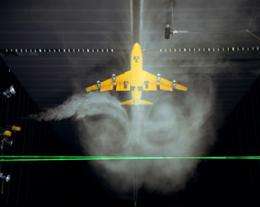Credit: Thinkstock
When testing numerical predictions regarding performance of aircraft, wind tunnels are still the next best thing to actual flight. EU-funded researchers improved the accuracy of test measurements with important implications for future aircraft design.
For wind tunnel testing of aircraft, scientists and engineers mount a model of the aircraft in the wind tunnel to maintain its position under varying forces, allowing a realistic simulation of performance.
Accurate measurement of forces and strains obviously requires accurate models. However, equally important in interpreting test results is understanding the effects of the mounting devices themselves given that they are not present during actual flight.
European researchers sought to evaluate various mounting devices and their effects on experimental measurements (particularly of Reynolds and Mach numbers) with EU-funding of the 'Flight Reynolds number testing' (Fliret) project.
The Reynolds number and the Mach number relate characteristics of flow such as velocity and viscosity. These two measurements are problematic in conventional wind tunnels whereas they are realistically simulated in cryogenic (very cold) wind tunnels. As such, the scientists focused on model mounting devices and effects in cryogenic wind tunnels using the European Transonic Wind (ETW) tunnel for study.
Scientists took the opportunity to evaluate existing numerical modelling methods such as computational fluid dynamics (CFD) and prediction tools. They clarified the advantages and disadvantages of existing modelling and experimental techniques and improved both for better synergy.
Four new model mounting devices (stings) were designed, manufactured and tested. Scientists estimated that an approximately 10 % increase in accuracy of measurements in cryogenic wind tunnels was achieved when compared to current state-of-the-art techniques largely due to decreasing interference between stings and models.
Fliret investigated an important area of aircraft model testing critical to interpreting results. The consortium's improvements in model mounting devices resulted in more accurate measurements of critical parameters. In the long term, implementation of Fliret concepts should lead to better designs for increased lift and manufacturing cost savings.
Provided by CORDIS





















